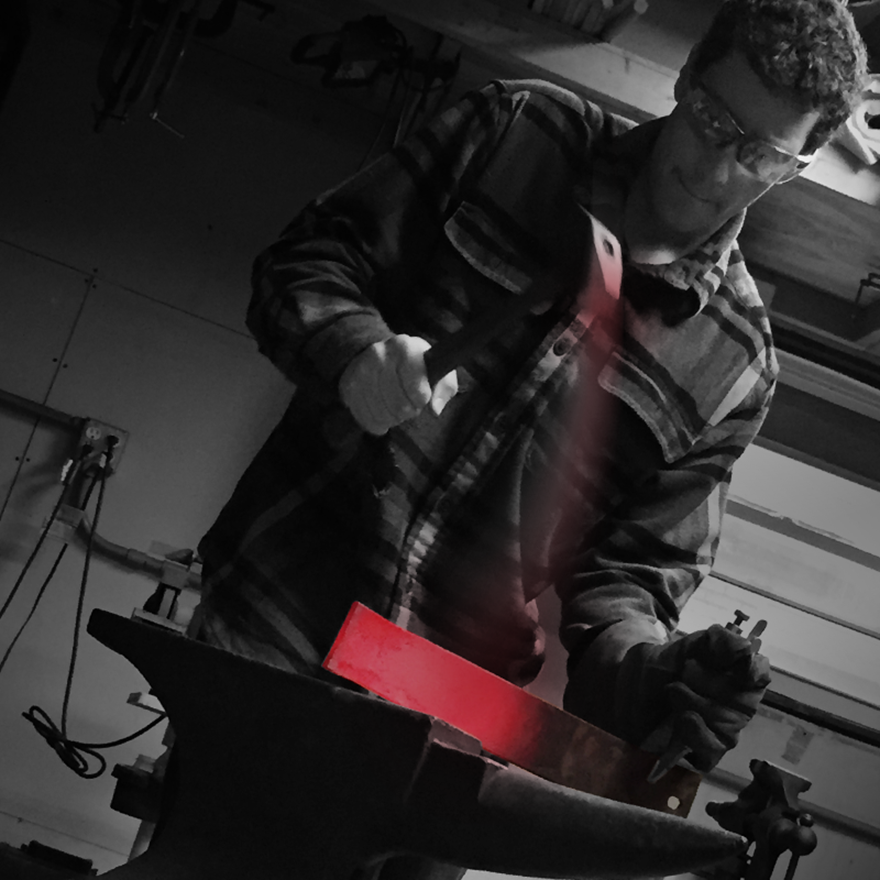Playing with fire
In David Sapiro’s garage, you’ll often find him leaning over a blacksmith’s anvil, crafting tools and blades from molten metals.
In the lab, David Sapiro studies the properties of corrosion in austenitic stainless steels. But in his garage, you’ll often find him leaning over a blacksmith’s anvil, hammering hot steel bars into new shapes, crafting tools and blades from molten metals.
When one thinks of science, one rarely thinks of fire or hammering, but Sapiro, who is pursuing his doctorate at Carnegie Mellon University in Materials Science and Engineering, blacksmiths in his spare time. Blacksmithing, or the creation of objects made from heated wrought iron or steel, is a trade not often associated with academia, but when designing and crafting many of his own tools—tongs, power hammers, chisels, and the like—Sapiro improves his creations by applying the science behind the metals to his hands-on hobby.
“In undergrad, I studied pure chemistry, and I also did blacksmithing on the side, so now I’m combining them with corrosion and metallurgy,” says Sapiro. “Corrosion is very much electrochemistry and studying individual atoms and molecules, very upper level science. But then the metal breaks, and I have to look at the fracture surface and say, was this a ductile fracture or a brittle fracture, and why did it break like that? That’s stuff I can do in my garage.”
Austenitic stainless steels, the most corrosion-resistant types of steel, are used in silverware, tubing, and other common household objects. Though they are resistant to corrosion, austenitic stainless steels still have their Achilles’ heels: salt water.

Source: College of Engineering
“Austenitic stainless steels don’t just rust like normal steel—they corrode in salt water and they can actually crack. So I’m working on trying to figure out when they do that, why they do that, and questions like that,” says Sapiro.
How a metal corrodes and breaks is all tied into blacksmithing, Sapiro explains. To see if a particular steel would be good to use when forging a knife, for example, you take it, heat it up, quench it, see if it’s hardenable, and then hit it with a hammer. And then, depending on how it breaks, it’s either good or bad for that use.
“And that’s why I like the research I’m doing and metallurgy in general,” says Sapiro. “Because you can get really nitty-gritty on the science, but you can also just go to your garage and use that science, hands-on.”
You can get really nitty-gritty on the science, but you can also just go to your garage and use that science, hands-on.
David Sapiro, Materials Science and Engineering Ph.D. student, Carnegie Mellon University
Sapiro doesn’t only make tools—he makes swords, using authentic blacksmithing techniques. Sapiro has forged several different types of swords in his garage: a pata (an Indian sword fashioned with a gauntlet around the fist traditionally shaped like an animal’s head), a falchion (a broad, single-edged sword), and a khopesh (the first sword ever made, an Egyptian sickle-shaped sword that evolved from the battleax). Currently, he is working with a group of other Carnegie Mellon students to forge a traditional Viking battleax.
What do swords have to do with academia? It turns out that TMS, one of the largest materials science conferences in the world, has recently incorporated an alternating bladesmithing competition and symposium into its annual proceedings. Sapiro entered the inaugural competition in 2015 with his creations—individually and in teams—and presented his findings at the symposium in 2016. He even published an article on the casting of his khopesh, “Fabrication of a Bronze Age sword using ancient techniques,” in TMS’s scientific journal, JOM. And come February, he’ll be competing in TMS 2017’s bladesmithing competition again, with his brand new flamberge (a wave-bladed sword).
So, whatever your interest may be, there is most certainly a science that can deepen your knowledge and augment your pastime. A perfect blend of technical and tangible, Sapiro is living the dream—working with his hands and pursuing a career studying the science behind his passion.
Hear Sapiro talk more about swordsmithing, metal corrosion, and the intersection between research and hobbies:
